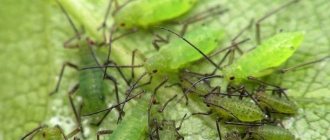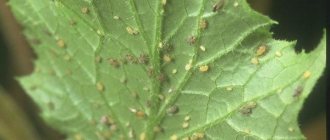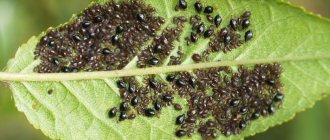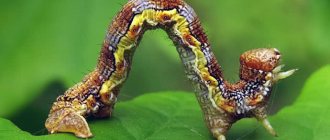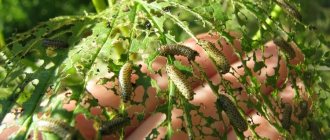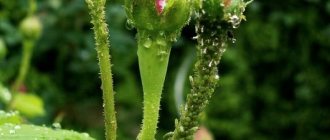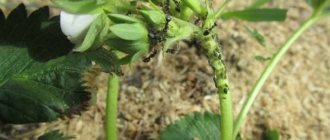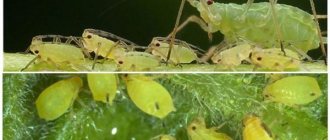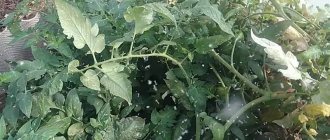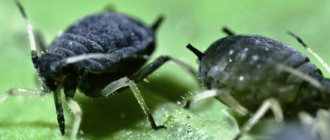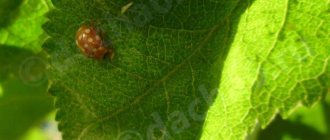Aphids can cause serious and lasting damage in a greenhouse. In addition to the fact that their populations are difficult to control due to their high reproductive capacity and resistance to many different insecticides, the rather favorable characteristics inside greenhouses create good conditions for overwintering and breeding of insects.
As our readers might have already guessed, the topic of our article today is the fight against aphids in a greenhouse. We will briefly recall the main biological features of this type of insect, tell you which species can most often be found in greenhouse conditions, and also tell you the main directions in the fight against them. The information will be very useful to anyone who is trying to remove these pests from their greenhouse plot.
"Greenhouse" species of aphids
Insects of all types of aphids, pests in the temperate climate of our country, are predominantly small (no more than 1-1.5 mm long), soft-bodied, pear-shaped insects with long legs and antennae. A characteristic feature of aphids are the so-called siphuncles - tubular formations that can be seen in the back of the abdomen.
Some of the most common species found in greenhouses include peach, melon, potato and foxglove aphids. In some cases, currant-lettuce and currant aphids can be found here, but given the absence of perennial shrubs in the greenhouses, in the bark of which the eggs of this species overwinter, they appear here relatively rarely.
Correct identification of the pest species is important in order to choose the most effective option for managing the insect population, however, at the domestic level, such data, as a rule, turns out to be superfluous - all insecticidal and biological agents work almost the same against any type of aphid. It is worth additionally noting that individuals of this type of insect can differ in color from each other, even when located on the same plant. Therefore, this indicator should not be relied upon to identify species.
Review of drugs
Bayer products performed well.
- A contact-type drug, the active substance is deltamethrin. Starts working within the first hour after treatment. Before use, the drug is diluted in water - approximately 1:10. 2 treatments are required with an interval of 7-10 days. The protective effect lasts up to 15 days if the product is not washed off. The fruits of the treated plant can be eaten only after 20-26 days.
- Contact-intestinal preparation against insects. It acts very quickly - most insects die in the 1st hour after treatment, the effect lasts up to 14 days. For 10 l. About 75 ml of water is required. drug. The need for repeated treatments is judged by the appearance of new insects on the plant. Due to its oily consistency, “Biskaya” is resistant to washing off. After treatment, you need to wait 7 days before consuming the plant.”Tanrek” - domestically produced, systemic type of action. For 10 l. Only 1-5 ml of water is required. facilities. The protective effect lasts 2-3 weeks. No re-processing required. You can eat plants and fruits only 10-20 days after spraying.
- Contact-intestinal action. To prepare 10 l. An aqueous solution requires only 2-4 ml of insecticide. Repeated treatments are carried out for repeated infections. The waiting period is 3-4 days.
Danadim
Low-toxic drug among chemical insecticides. Its effect appears within 48 hours after application. For treatment, prepare a solution, add approximately 25 ml of the drug to 10 liters of water, after which spraying is carried out. The effect lasts for 2-3 weeks, after which re-treatment is carried out.
If there are only a few aphids, less toxic chemicals will help get rid of them. For example, a Bordeaux mixture consisting of copper sulfate, quicklime and water. It is made at home by adding 10 liters. water 100 gr. each component, or purchase a ready-made one. After application, the effect lasts 10-14 days, then you can spray again, but no more than 4 times per season. Spraying against aphids should be done 2-4 weeks before harvest.
Copper sulfate is also used separately. For 10 l. You will need 100 grams of water. If necessary, the solution is “strengthened” with soap or a special insecticide “green soap” (300 g per 10 liters of water). Treat against aphids every 14 days, but 4 weeks before harvesting the fruits.
Packaging of Russian-made copper sulfate “Green Belt”.
How to assess the safety of an insecticide?
Each drug, both chemical and biological, is assigned a certain hazard class for humans (from 1 to 4) and for bees (from 1 to 3). The higher the number, the less toxic the insecticide and there are fewer restrictions on its use. Usually this information is indicated by the manufacturer on the label.
If there is no such information, then you should refer to the “Catalogue of Pesticides and Agrochemicals Permitted for Use on the Territory of the Russian Federation” - a publication published annually by the Russian Ministry of Agriculture.
The catalog can be downloaded from our website. It contains information about all plant protection products officially registered in Russia. There you can also find information about the manufacturer, application features, dosages, consumption rates and toxicity of each drug. This publication allows you to independently select the right remedy for a specific crop against a specific pest or disease.
You need to be wary of Russian drugs that are on the market but not included in the catalogue. They may not have been manufactured correctly and may be dangerous.
melon aphid
Slightly smaller in size than its predecessor. The appearance is characterized by more significant color changes within the same colony. The melon aphid can be yellow, green, purple-gray or black in color with characteristic white spots on the abdomen. The short siphuncles are completely black. Due to their predominantly dark coloration, representatives of this species are often called black aphids.
Greenhouse
In greenhouse conditions, several different forms of greenhouse aphids can exist simultaneously. Otherwise it is called green peach, because this particular crop is its primary host. But there is no need to have any illusions - the greenhouse aphid is omnivorous, like most of its relatives. Cucumbers, tomatoes, fresh salads or greens will be used.
In a greenhouse, a colony of aphids reproduces up to 14 times a year. The maximum size is 2.5 mm. They come with and without wings, green, black and black-green. If the damage has reached 25% of the leaves, then obtaining cucumbers, peppers or tomatoes is a big question. Develops from +10°C.
Nutrition and harm
Aphids feed by piercing the phloem of a plant with their elongated proboscis, which they use to suck the sap from the plant. When aphid populations reach large sizes, the plant may become weak and significantly slow down its growth. In addition, noticeable damage to the leaves is observed, which looks like curling.
As they feed, aphids release a very sweet substance known as honeydew into the environment. Accumulating on the lower leaves of the plant, honeydew promotes the growth of mold fungi, which looks like a black, sooty coating, which in turn reduces the quality of photosynthesis.
As they molt, the whitish shed exoskeletons of the aphids can be found on the ground near the root of the plant, which may indicate long-standing and severe damage to the plant. Often these remains can be mistakenly confused with another pest - whitefly.
Among other things, in a large community of aphids there are always ants that feed on sweet honeydew.
Manifestation
Aphids in a greenhouse are almost invisible to the eye. First, aphids settle on the lower part of the leaves, and only then on the buds and young shoots. It sucks the vital juices out of them, as a result of which the leaves curl, the shoots grow poorly, the flower stalks become bent, and the buds dry out without ever blooming. In bulbous perennials, in addition to the ground part, the bulb itself is also damaged.
At the same time, the pests secrete sugary excrement, “honeydew,” which freely spreads throughout the plant, attracting ants, wasps, flies and bees. Sedentary aphids are in symbiosis with ants, supplying them with food, and the ants protect it and move it to a new place (this applies to wingless individuals).
IMPORTANT! The hidden danger is that various phytopathogenic viruses are transmitted along with aphids. If the first moment of the appearance of pests is missed, then your greenhouse will soon have a completely depressing appearance. Colonies of parasites can ruin all greenhouse plants.
How to deal with aphids in a greenhouse - the basics
Before planting, you first need to check the incoming planting material and sludge for signs of aphids. If there are no perennial plants growing in the greenhouse, and the entrances are closed with a dense mesh, then there is nowhere to get aphids here except by drift.
In addition, aphid damage can occur when a lot of last year's weeds remain in the greenhouse. Therefore, you need to ensure that the entire greenhouse area is properly prepared for winter.
From the external environment, aphids can be carried on outer clothing, so you need to pay attention to small green flies with wings. The use of excess soil fertilization with urea not only promotes lush plant growth, but is also beneficial for the development of aphids, since nitrogen is the main source of energy for this type of insect.
Emergency methods of control
If the aphid is taken by surprise, then you can overcome it using the following emergency methods:
- Russian ordinary vodka. You need to put a sprayer on a bottle of the cheapest vodka - and the product is ready! Vodka has an excellent effect on aphids as a disinfectant. But it is worth considering that alcohol can harm the plant, leaving burns on it;
- Coca Cola. As in the previous recipe, you need to put a spray bottle on the neck of Coca-Cola and spray the pests from it. Due to the fact that this drink contains orthophosphoric acid, this fact explains the harmful effect of Coca-Cola on aphids;
- milk and iodine. If you mix milk and iodine in equal proportions, you can get the No. 1 killer against aphids. Perhaps this method is the most gentle for a damaged plant.
Timely detection of aphids is the best control method when processing a greenhouse
Regular, at least weekly, inspection of plants is necessary to detect aphids before their populations reach large sizes.
Particular attention should be paid to random weeds that are always forgotten about. Check for the presence of whitish shed chitinous covers and honeydew. Green peach aphids tend to be distributed more evenly throughout the crop, while melon aphids are more likely to be found in isolated “hot spots.” In addition, melon aphids are much less likely to form winged individuals, which more often linger on the lower surfaces of leaves and along the stem of the plant.
The foxglove aphid injects toxic saliva into leaf tissues, which leads to distortion of their shape, as well as their loss. In addition, this species is less heat-loving than others, so its attacks will continue even after the temperature drops.
Method 2: soap-oil suspension with soda
You can enhance the effectiveness of the soap solution using various additional ingredients. For example, a product with soda and vegetable oil has proven itself well:
- 100 ml of vegetable oil, 2 glasses of water, 1 tablespoon of liquid soap and 2 teaspoons of soda are added to an empty two-liter plastic bottle;
- the bottle is closed and the entire contents are thoroughly shaken until a suspension is formed;
- the prepared uterine suspension is diluted in 5 liters of water.
The resulting working solution is poured into a garden sprayer and evenly distributed over the peppers affected by aphids.
Biological control
To get rid of aphids, some biological methods show good results. In open ground, in our climate, aphids do not have many natural enemies. The main ones include ladybugs, lacewings, and wasps.
Fungal diseases can also help provide a degree of control over pest populations.
It is quite difficult to breed and keep a ladybug within your garden on open ground. But inside the greenhouse this is much easier to do. Therefore, if it is possible to buy larvae of this species and release them in a greenhouse, it is better to do so. Other means of control may no longer be relevant.
Parasitoids are organisms that parasitize the body of their host and then kill him. A good example for aphids is the wasp A. colemani, which attacks peach and melon aphids.
Prevention of occurrence
It's always nice to prevent problems rather than solve them.
Preventive measures against aphids will allow you to never encounter such a scourge.
Plants that repel aphids
If you are not afraid of competition, that cucumbers will not share space with other plants, then you can try the scaring method.
If a few years earlier the cucumber plantings were already subject to aphid attacks, it is worth planting repellent plantings around the plants.
Aphids are afraid of smell:
- garlic,
- Luke,
- celandine.
Be sure to plant these plants along the cucumber beds. This will reduce the likelihood of pests.
Strengthening the immunity of cultivated plants
It is necessary to strengthen the immunity of your plants.
Without proper procedures, plants will be very susceptible and aphids will quickly appear on them.
- You need to water the plants not with warm, but with slightly cool water.
- There is no need to cover the cucumbers, thereby saving them from rain and gusty winds.
- You should not grow cucumbers in greenhouse conditions. Even if the plant grows in a greenhouse, open the windows as often as possible and ventilate the room.
- Do not create too much humidity.
- Don't be afraid of direct sunlight. Yes, and they dry the upper part of the foliage, but aphids definitely won’t settle here.
- Of course, it is necessary to give preference to natural fertilizers.
The stronger the plant, the less likely it is that aphids will develop on it.
Fertilize the soil with ash, manure, mullein, urea, and humus. All these natural ingredients can always be found in the private sector.
Attracting biological enemies
The main enemy of aphids is the ladybug. This insect feeds on aphids, which means it is your ally.
How to attract a ladybug to your territory?
Ladybug is not indifferent to sweets. Therefore, gardeners selectively lubricate some cucumber leaves with sweet water or even soda.
Coca-Cola works great.
By soaking a few leaves in this drink, you will ensure the presence of ladybugs in your immediate vicinity around the clock. Why don't you need security?
Pathogens
There are several types of entomopathogenic microscopic fungi that have been specifically bred for use against greenhouse pests. The two commercially available species are Beauveria and Paecilomyces.
Beauveria bassiana is a soil fungus that can be found anywhere in the world. Fungal spores (conidia) infect the insect through the cuticle. Their shell contains enzymes that dissolve the cuticle of the insect, and then the spore penetrates the body. Once it enters the insect's body, the fungus produces a toxin that weakens the host's immune system. This fungus requires high relative humidity and moderate temperature, and 8 to 10 hours to be effective in insecticidal control.
It is worth noting that Beauveria cannot be compatible with ladybugs or other insects used in aphid control, as it will kill them too.
Paecilomyces fumosoroseus is a naturally occurring fungus found in infected dead insects and some soils. The fungus attacks the insect by penetrating the outer shell of the insect. Otherwise, the principle of the beneficial action of the fungus is the same as the previous description.
Spider mites on tomatoes
Spider mites are tiny insects that are almost invisible to the naked eye. But the “results” of its harmful activity are clearly visible on tomatoes - stems and fruits entwined with a thin whitish mesh of cobwebs. Damage to tomato plants is caused by both larvae and adult spider mites (there are also several types of them), which suck the juice from the plants and entangle the leaves, causing them to turn yellow, dry out and fall off.
Spider mites prefer dry air, so they most often harm tomatoes with scanty watering in dry summers or with rare ventilation in the greenhouse. This arachnid reproduces with lightning speed, so if the gardener is inactive, it can quickly “master” all the plants nearby.
How to fight spider mites? First of all, as always, take timely measures to prevent its occurrence. Destroy weeds (quinoa is especially dangerous in this regard), dig up the soil, regularly remove and burn damaged leaves, water and ventilate tomatoes in a timely manner.
If preventive measures have not helped, and the spider mite is already living on your tomatoes, you need to take control measures. If possible, protect damaged plants and treat the plantings with warm water with added soap (40 g per 10 l) or infusion of garlic or onion peels (200 g of peel per 1 l of water).
Biological methods of protecting tomatoes from spider mites include treatment with Fitoverm, Bicol or Bitoxibacillin (according to instructions), as well as the introduction of the predator mite phytoseiulus onto the plantings.
Chemical - spraying with solutions of Akarin (2 ml per 1 liter of water), Novaktion (1 ml per 1 liter of water) or Fufanon (same proportions).
How to get rid of spider mites in a greenhouse - useful tips Small, invisible pests can destroy the entire crop in a greenhouse. But even on them you can find control.
How to treat a greenhouse against aphids in the spring - using insecticides
Aphid populations are difficult to control with insecticides for a number of reasons. Failures may be due to poor application technique, insufficient coverage, or high pH in the spray tank. Unfortunately, many gardeners do not pay attention to these subtleties and completely in vain.
When trying to treat aphids with chemicals, you need to remember that:
- If aphids are present on the flowers of plants whose fruits are used for food, insecticide treatment can be dangerous and, in addition, not very effective.
- In the spring, the first generation of aphids just crawls closer to fresh foliage, so spraying with insecticides will have the effect of firing a cannon at sparrows.
- Aphids can be difficult to reach if they are on the undersides of leaves, especially close to the soil, as is the case with foxglove aphids.
- Among peach aphid populations, resistance to organophosphates, carbamates, and pyrethroids has been reported.
- Winged forms of the melon aphid are more resistant to the action of organophosphorus pesticides than its wingless forms.
- Treating the root part of the plant with chemicals may be more effective since aphids tend to ingest large quantities of plant sap, especially in the spring.
We really hope that the information in this article will help all beginners, as well as experienced gardeners, to remove aphids from their greenhouse. In conclusion, I would like to note that if there are no perennial weeds or their roots in the greenhouse, and shrubs do not grow, then in order to prevent the appearance of aphids here, it will be quite enough to observe their penetration through introduction with seedlings, flying into unprotected windows and doors, and also on your clothes. We wish only high yields!
Preventive measures
In the confined space of a greenhouse, it is worth carrying out comprehensive work to prevent the development of pests and diseases. After harvesting, it is necessary to disinfect the structure itself, tools and soil in the greenhouse.
Processing the greenhouse and equipment in the fall
Treatment of the greenhouse after harvesting consists of washing the structure and disinfecting it. Metal parts and windows can be washed with soapy water or bleach. Fumigation with a sulfur bomb is perfect for disinfection.
The procedure for treating a greenhouse in the fall with a saber is as follows:
- The first step is to ensure the integrity of the coating of the metal parts. If the enamel has chips or cracks, they must be primed and painted over. If this is not possible, cover with a thick layer of grease to prevent corrosion.
- It is necessary to make sure that all windows and doors close tightly, there are no cracks or holes, so that the gas does not evaporate in vain.
- A non-combustible base (brick, metal basin) is placed on the ground in the center of the greenhouse, and a checker is placed in it. The checker is set on fire.
- Next, you need to leave the greenhouse as quickly as possible, closing the door tightly.
Tilling the land in autumn
Soil treatment is carried out in several stages.
- All plant residues, wooden pegs, and strings are removed and burned so that pests do not hide in them for the winter.
- The earth is being dug up.
- Then the soil is disinfected. To do this, the ground can be watered with a solution of copper sulfate or Bordeaux mixture.
- If the design of the greenhouse allows, you can leave a window or door open for the winter. The soil will freeze, the pests and eggs that remain in it will die.
Advice! To further freeze the soil in the greenhouse in winter, you can throw a 20-30 cm layer of snow on the beds and leave it until spring. Melted snow will additionally moisten the soil with the arrival of warmth.
Signs of defeat
Since eggplants are a heat-loving crop, they are often planted in a greenhouse. But this is not an obstacle for aphids, which can slip into the greenhouse during ventilation or simply remain in the ground since wintering. Ants are also “taxi drivers” for aphids; they carry the pest on themselves – and into the greenhouse as well.
You can determine that it is aphids that parasitize eggplants by the following signs:
- a white coating appeared on the plant;
- it seems that there are more ants in the ground;
- if you examine the leaves, stems and flowers of eggplants, you can see colonies of small insects;
- sugary discharge appeared on the leaf petioles;
- the leaves curl and turn yellow and become covered with brown spots;
- flowers and ovaries wither and fall off.
The aphid's job is to drink all the juices from the plant, which is how it survives. But by depriving eggplants of nutrients, it also blocks their flow to the roots. Accordingly, the growth of seedlings slows down and they begin to dry out. If there are a lot of aphids on eggplants, there is a high risk that black mold will appear, and it practically kills the metabolic processes inside the plant. But this is not all the dangers of aphids - often they infect crops with diseases, serve as their carrier, that is, they can completely destroy the planting.
